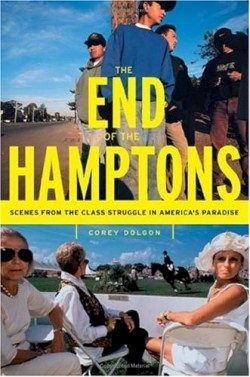The End of the Hamptons
Scenes from the Class Struggle in America's Paradise
Efforts by the Shinnecock Indians to build a casino in Hampton Bays have provoked cries that it will mean the “end of the Hamptons.” This is not the first time people have lamented that life as they know it on the East End of Long Island is coming to an end. The author, associate professor of sociology at Worcester State College, observes that the history of the Hamptons has been one of successive groups taking over the region, only to find themselves inundated by the forces of new migration. Ironically, it’s a sequence that began 350 years ago when the Shinnecocks’ land was snatched away by early Puritan immigrants. Focusing on the Hamptons today, where a new hyper-bourgeoisie elite is locked in an uncomfortable embrace with Latino laborers lured by a burgeoning service industry, Dolgon tells a history that is balanced and agenda-free.
In order to show how historical forces shape the present, Dolgon commences with an extended overview of past migration patterns. He writes of waves of “conquerors,” including Manhattan bohemians and aristocrats of the late nineteenth century, Eastern European immigrants of the early twentieth century, and post-World War II middle-class professionals, who radically and permanently changed the physical and cultural landscape of the Hamptons.
Today’s Hamptons are portrayed as a poster community for McMansion landscapes. Land use has shifted from producing vegetables to providing vistas, and wealthy subdivisions cluster around old potato fields. Dolgon describes a contemporary obsession with celebrity and image along with a desire to identify the Hamptons as home, not just a summer getaway, and a characteristic that distinguishes the new bourgeoisie from their predecessors. New homebuyers are said to turn into vociferous anti-development activists as soon as their contractor hammers home the last nail.
Using polo and soccer as unusually effective sports metaphors, Dolgon suggests that for wealthy enthusiasts, polo represents the new elite’s attempt to resurrect images of old money within a contemporary setting of new wealth and celebrity. For Latino soccer players and fans, their games offer a chance to see and converse with one another, to reaffirm their common heritage and their evolving identity. For readers wondering why anyone should care about the Hamptons, Dolgon argues that the Hamptons are an animated, high profile exhibit of social forces and cultural experiences, and that what happens at the East End of Long Island is a microcosm of what is happening everywhere else.
Reviewed by
Rob Mitchell
Disclosure: This article is not an endorsement, but a review. The publisher of this book provided free copies of the book to have their book reviewed by a professional reviewer. No fee was paid by the publisher for this review. Foreword Reviews only recommends books that we love. Foreword Magazine, Inc. is disclosing this in accordance with the Federal Trade Commission’s 16 CFR, Part 255.

